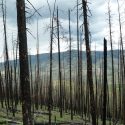Saving the Point of Rocks
It may be one of the toughest rocks on Earth, but even Baraboo Quartzite is no match for a road crew.
Instead it has taken the concerted efforts of state and University of Wisconsin–Madison geologists and sympathetic highway engineers to save a prominent quartzite outcrop along Highway 12 two and a half miles south of Baraboo. Recently slated for destruction as part of a planned roadway expansion, the outcrop known as the Point of Rocks is now protected as a State Historic Place and may soon receive a national listing as well.
The Point of Rocks is part of an exposed ridge of bedrock in the Baraboo Hills. It is visible on the east side of Highway 12 one mile north of the Ski-Hi orchard, where the road curves sharply through a highway cut through the rocks.
Two things make these 1.7 billion-year-old rocks very special: geology and history, says Robert Dott, Jr., a geologist who helped lead the conservation effort.
Geological surveys of the area kicked off in the latter half of the 19th century as the rocks were found to contain one of the upper Midwest’s iron deposits — a commodity of great interest at a time of burgeoning American industry.
“That was very important because the U.S. had not had a significant domestic source of iron,” says Dott, a UW–Madison professor emeritus of geology. “We had to import much of our metal ores from abroad, and so having this rich iron source in the Great Lakes region was of great importance for stimulating industrialization.”
Much of the early exploration was led by noted UW–Madison geologist Charles R. Van Hise. Over time, scientific studies at the Point of Rocks and elsewhere in the Baraboo Hills — the remnants of an ancient and now greatly eroded mountain range — have helped geologists develop a better understanding of Wisconsin’s geologic history, including rock deposition and both large- and small-scale surface deformations.
The accessibility and clarity of the features also make the area ideal for bringing students and other groups for teaching purposes, Dott says, and it is common to see vanloads and buses of students at the Point. Many surfaces are covered with visible ripple marks that have allowed researchers to study currents flowing in the shallow sea that once covered the area. Visitors can also see deformational features that Van Hise’s group used to develop fundamental principles for deciphering complex geological structures. For example, they showed that the Baraboo Quartzite had been buckled into a large downfold called a syncline.
When Dott and other members of the UW–Madison Department of Geoscience caught wind of the proposed highway expansion plans, they took action to protect the site. In 2007, together with State Geological Survey geologists, they organized a guided tour of the site for DOT engineers to show the scientific, educational, and historical importance of this outcrop.
“We were preparing for a big battle,” Dott recalls, but “the engineers were easily persuaded, to our great pleasure.”
In fact, the DOT suggested having a study done to see if the site was eligible for protection by listing as a state historic place. Work by Consultant Jennifer Harvey showed that the Point of Rocks easily met the eligibility criteria, and the DOT rerouted the highway plans slightly west to preserve the outcrop.
That was enough for the DOT, but not for Dott.
“As far as the Department of Transportation was concerned, that was all it cared about, eligibility. From DOT’s point of view, that would protect the sites,” he says. “But I wasn’t satisfied with that. If it’s eligible, why don’t we get the full status?”
He followed through and, a thick sheaf of paperwork later, the Point of Rocks was officially added to the Wisconsin State Register of Historic Places on Feb. 19, 2010. The outcrop is currently awaiting a decision for listing on the National Register of Historic Places.
Dott, who still does research in the Baraboo Hills, is pleased with the outcome so far and optimistic about the pending federal approval.
“If it were a Native American camp site, there are laws that protect that sort of thing, just as there are for ecologically important sites,” he says. For geologic sites, “we don’t get that. We have to try for it ourselves.”
Subscribe to Wisconsin Ideas
Want more stories of the Wisconsin Idea in action? Sign-up for our monthly e-newsletter highlighting how Badgers are taking their education and research beyond the boundaries of the classroom to improve lives.



